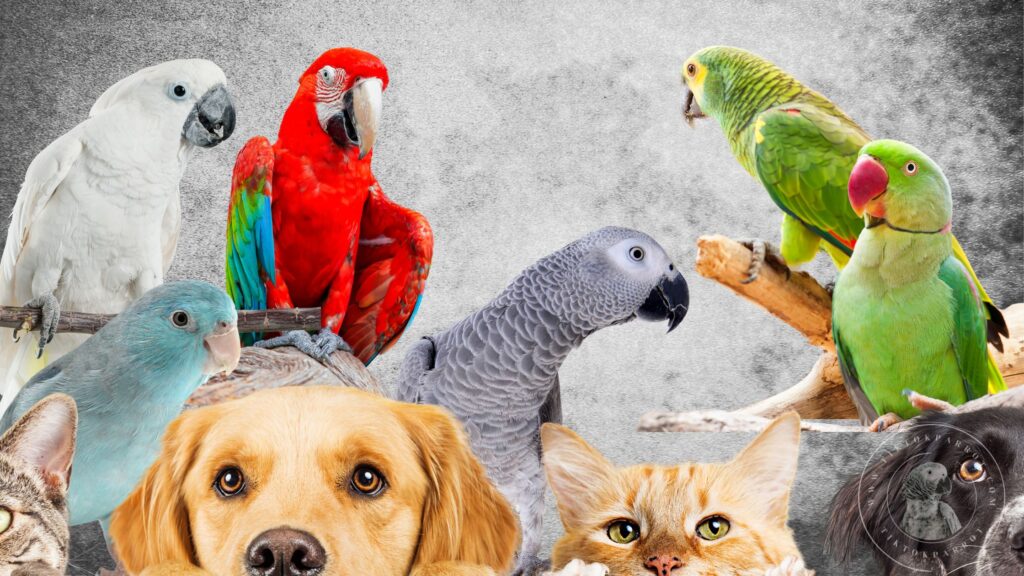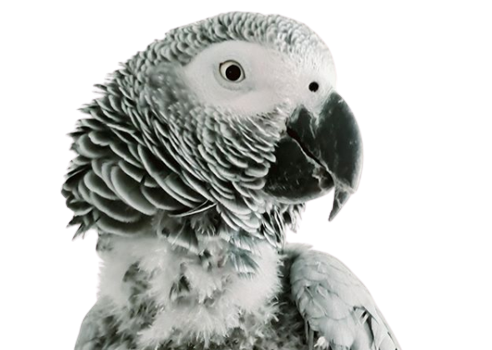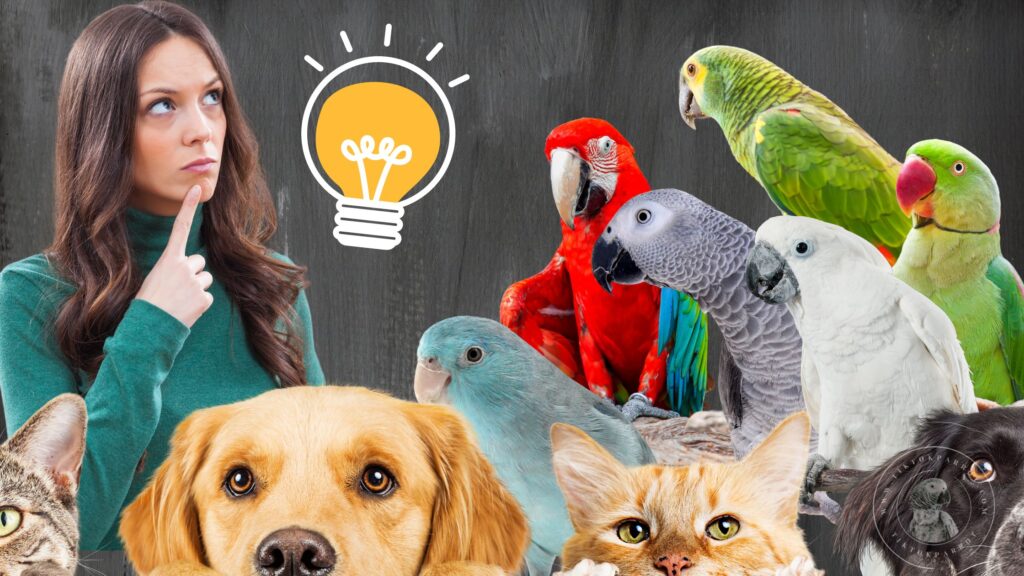Welcome to TikTokParrot, where we celebrate the quirky, the feathered, and the challenges of multi-species families. Today, we’re tackling a hot topic: keeping African Greys with other pets. Picture this – a chatty parrot, a curious cat, and a dog with a wagging tail. Is it a recipe for heartwarming interspecies friendship…or utter chaos? Let’s find out!
Keeping African Greys with Other Pets
African Greys are undoubtedly one of the most beloved parrot species, known for their intelligence, charm, and quirky personalities. But what happens when you want to expand your furry family and bring other pets into the mix? Can African Greys coexist harmoniously with other birds, dogs, cats, or even smaller critters like hamsters? Let’s explore this intriguing topic together!
Can African Greys live with cats or dogs? Discover the secrets to successfully keeping African Greys with other pets! Learn tips, tricks, and insights for creating a harmonious multi-species household.

First things first, let’s address the elephant in the room – or should I say, the cat or dog? Introducing a new pet into your African Grey’s territory can be a bit nerve-wracking, but with patience, preparation, and proper supervision, it’s definitely doable. Remember, every parrot and pet is unique, so it’s essential to gauge your African Grey’s temperament and adjust accordingly.
When introducing African Greys to dogs or cats, start slow and steady. Allow them to get acquainted with each other’s scents and sounds from a safe distance before moving on to face-to-face interactions. Always supervise their interactions closely, and be prepared to intervene if things get too rowdy. With time and positive reinforcement, many African Greys can form close bonds with their furry siblings, enjoying snuggles and playtime together.
As for smaller pets like hamsters or guinea pigs, the key is to provide adequate separation and supervision. African Greys have strong prey instincts, so it’s crucial to ensure that smaller animals are housed securely in cages or enclosures that are inaccessible to your parrot. Even the most well-behaved African Grey can’t resist the temptation of a scurrying hamster!
Ultimately, successful cohabitation between African Greys and other pets boils down to patience, proper introductions, and respect for each animal’s individual needs. By creating a safe and nurturing environment where all pets feel valued and respected, you can foster harmonious relationships and create lasting bonds that enrich both your life and theirs.
The African Grey Factor: Things to Consider
Before welcoming a furry or scaly friend into your Grey’s domain, remember these key points:
- Boss Bird: African Greys are intelligent, independent, and sometimes a bit bossy. Sharing their territory might take some convincing!
- The Noise Factor: Greys love to vocalize. Can your other pets handle the squawks, whistles, and the occasional talking marathon?
- Safety First: Even supervised playtime can pose a risk to a smaller animal if your Grey decides to get territorial.
Cats and Greys: A Risky Mix
Let’s be real; cats and parrots are natural rivals. Remember that predatory instinct? Even if your kitty is sweet, a playful swat can seriously injure a bird. While some manage successful cohabitation, it’s often a case of tolerating each other rather than true friendship.
Dogs and Greys: Can It Work?
Size certainly matters! A boisterous dog and a Grey are a potential safety hazard. But calm breeds, introduced carefully, sometimes forge a surprising bond. It depends on the personalities of both the dog and the parrot. Think of them as unlikely roommates who might occasionally tolerate each other.
Other Animals:
- Small Pets: Hamsters, rabbits, etc., are best kept in a separate, parrot-proof area. They’re more like a feathery TV show than a potential friend for your Grey.
- Birds: Canaries, budgies… think of them as potential snacks for a Grey, not roommates. Similar-sized birds might work if they have separate cages and closely supervised playtime.
Tips for Multi-Pet Harmony (Sort Of)
If you’re determined to make it work, here’s how to increase the odds:
- Slow and Steady: Introductions should be gradual, first with the animals safely in their cages, then with supervised, short interactions.
- Separate Spaces Rule: Give your Grey a safe haven – their cage is their castle! Other pets shouldn’t be allowed near it.
- Training is Key: A well-trained dog who responds to commands is a safer bet around a Grey.
- Enrichment Galore: A bored parrot or a bored dog is more likely to cause trouble. Keep everyone occupied with toys, foraging, and training.
- Supervise, Supervise, Supervise!: Never leave them alone unsupervised, even for a minute.
When It’s a Definite No
Some situations are a recipe for disaster:
- Aggressive Animals: If your dog or cat shows any signs of prey drive or aggression, it’s not worth the risk.
- A Stressed Grey: If introducing other pets is causing anxiety for your Grey, it’s time to rethink the plan. Their well-being comes first!
Do African Greys Get Along with Other Birds
African Grey parrots are captivating creatures, renowned for their intelligence, stunning plumage, and impressive mimicry skills. But for aspiring owners, a crucial question often arises: Do African Greys get along with other birds?
The answer, like many things in the avian world, isn’t a simple yes or no. African Greys can form strong bonds with humans, but their social dynamics with other birds can be complex. Above we talk about dogs and cats living with African grey parrot. Now, we’ll delve into the factors influencing their interactions and explore ways to create a harmonious multi-bird environment, if that’s your desired path.
Flock Mentality vs. Single-Minded Devotion
African Greys, in their natural habitat, are social creatures. They live in flocks, foraging, preening, and communicating together. This inherent social nature might lead you to believe they’d seamlessly integrate into an aviary setting. However, their social needs in captivity differ quite a bit from those in the wild.
The Challenge of Competition
In a domestic environment, African Greys often form deep attachments to their human companions. This strong bond can translate into possessiveness and jealousy towards other birds competing for your attention. They might become territorial, displaying aggression like feather-plucking, squawking, and even physical attacks to chase away the perceived threat.
The Importance of Individuality
African Greys, like humans, possess distinct personalities. Some are naturally gregarious, showing curiosity and openness towards other birds. Others are more introverted, preferring solitude and potentially experiencing stress in a shared space. Understanding your Grey’s personality is key to determining if a feathered companion would be a welcome addition.
Considering Species Compatibility
Even if your African Grey seems open to sharing their space, species compatibility matters. African Greys are typically larger than budgies or finches, creating a potential power dynamic that can lead to intimidation or even injury.
Larger parrots, while seemingly on equal footing, could also ignite territorial disputes. Generally, parrots of similar size and temperament offer the best chance of a successful cohabitation. Some potential compatible species include:
- Senegal Parrots
- Congo African Greys (a subspecies)
- Timneh African Greys (a subspecies)
- Amazon Parrots (depending on species and individual personalities)
Introducing Birds the Right Way
If you’re determined to have multiple birds, a well-executed introduction process is crucial. Here are some key steps:
- Quarantine: Before introducing any new bird, ensure they undergo a quarantine period to prevent the spread of potential illnesses.
- Separate Cages: Initially, house the birds in separate cages within close proximity, allowing them to become accustomed to each other’s sights and sounds.
- Positive Reinforcement: During cage time interactions, reward positive behavior with treats and praise. This helps create positive associations with the other bird.
- Neutral Territory: For supervised out-of-cage interactions, choose a neutral space unfamiliar to either bird. This reduces territorial instincts.
- Gradual Supervision: Start with short supervised interactions, gradually increasing the duration as comfort levels improve. Be prepared to separate them at any sign of aggression.
Signs of Trouble and What to Do
If you observe any aggression, like hissing, screeching, chasing, or feather-plucking, separate the birds immediately. Consult an avian veterinarian or experienced bird behaviorist for guidance on further socialization attempts or alternative housing arrangements.
Alternatives to Multi-Bird Ownership
If, after careful consideration, you decide a multi-bird household isn’t the best fit for your African Grey, don’t despair! Here are some ways to enrich their social lives:
- Increased Human Interaction: Dedicate ample time each day for dedicated interaction, training, playing, and cuddling.
- Interactive Toys: Provide a variety of stimulating toys to keep them mentally engaged and prevent boredom.
- Bird TV or Music: Play calming or engaging bird-specific videos or music to provide background noise and enrichment.
- Bird Playdates: Consider supervised playdates with other compatible African Greys owned by friends or family.
The Joy of a Well-Matched Companion
While introducing another bird requires careful planning and doesn’t guarantee success, witnessing a blossoming friendship between two parrots can be a truly heartwarming experience.
Ultimately, the decision of whether or not to get another bird rests on your African Grey’s personality, your resources, and your commitment to providing a safe and enriching environment for everyone involved.
Remember: Your African Grey’s well-being is paramount. If introducing another bird creates undue stress or jeopardizes their happiness, prioritizing their comfort is the most loving choice.
My Final Thoughts
Sharing your life (and home) with an African Grey and other pets is possible, but it takes careful planning, patience, and a healthy dose of realism. Sometimes, the best solution is for your Grey to be the undisputed king or queen of the castle, with furry friends admired from afar.
As I mentioned about, by prioritizing safety, supervision, and positive reinforcement, you can create a harmonious multi-species household where all members – feathered, furry, or otherwise – can thrive.
Has anyone successfully managed a multi-species household with an African Grey? Share your stories (and tips!) in the comments below!
Also you are welcome to join our pet community, at TiktokParrot community, we’re all about building a vibrant community of pet lovers where you can share your experiences, seek advice, and connect with fellow pet enthusiasts.
If you found this blog helpful, It would be great if you could share it with your family and friends who might find it useful as well.
You might like to read these as well 🙂
Perch Perfect: Creating a Stimulating Environment for Your Parrot
Things you need to know about an African Grey Parrot’s Cage
The Importance of a Cage for Your African Grey Parrot
Understanding Your African Grey Parrot Nature and Type
African Grey Parrots: Do They Have a Secret Sense of Smell?
How Do We Take Care of an African Parrot Grey’s Health?
How to Rear a Young African Grey Parrot
What causes death in African Grey Parrots?
For more useful content about African grey parrots, you can subscribe my site with your email to get notification upon publishing a new blog, the subscribe box you can see on the right side of this page. Also if you get an alert on your web browser while browsing my site, allow it and that will also give you an alert whenever I publish a new blog. 🙂
Stay safe and much love!



